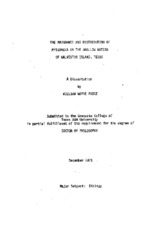| dc.contributor.advisor | Sweet, Merrill H. | |
| dc.creator | Price, William Wayne | |
| dc.date.accessioned | 2020-08-21T21:47:50Z | |
| dc.date.available | 2020-08-21T21:47:50Z | |
| dc.date.issued | 1976 | |
| dc.identifier.uri | https://hdl.handle.net/1969.1/DISSERTATIONS-474090 | |
| dc.description | Vita. | en |
| dc.description.abstract | The distributions, relative and seasonal abundances, and population structures of the species of mysids were sampled for 2 years in the < various habitats in the shallow waters of Galveston Island, Texas. From February, 1971 through January, 1972, monthly collections were made and from February, 1973 through February, 1974 bimonthly collections were made with a beam trawl in the nearshore area. During the second year bimonthly samples were taken with an Ockelmann sledge along transects across Tucker Bayou and West Bay. Mysidopsis almyra was the dominant species in the study, composing 82 per cent of the collections. The next 3 most abundant species were Mysidopsis bahia (10 per cent), Mysidopsis bigelowi (5 per cent), and Metamysidopsis swifti (4 per cent). The ecological distributions of the mysids showed a pattern of habitat segregation among the species: Mysidopsis almyra occurred in lower salinity shallow waters of bayous and bays; Mysidopsis bahia in shallow bay waters of higher salinity; Mysidopsis bigelowi in deeper bay waters and offshore; Metamysidopsis swifti in seaside surf; and Brasilomysis castroi and Promysis atlantica in deeper offshore waters. Microdistribution studies showed that M. almyra inhabits the layer of water just above the bottom during the day and night. As the tide ebbed, its numbers increased and as the tide flooded numbers decreased. All mysid species displayed similar cycles of rapid reproduction and larger numbers during the summer months and slow reproduction and low numbers during the winter months. It was concluded that photoperiodicity and temperature were the major factors involved in these seasonal changes. The largest gravid females of all species were collected in the winter months and were replaced by progressively smaller ones in the spring and summer. The number of eggs and young per brood was calculated to be a linear function of the volume (length³) of female M. almyra, M. bahia, M. bigelowi, and M. swifti. | en |
| dc.format.extent | xvi, 207 leaves | en |
| dc.format.medium | electronic | en |
| dc.format.mimetype | application/pdf | |
| dc.language.iso | eng | |
| dc.rights | This thesis was part of a retrospective digitization project authorized by the Texas A&M University Libraries. Copyright remains vested with the author(s). It is the user's responsibility to secure permission from the copyright holder(s) for re-use of the work beyond the provision of Fair Use. | en |
| dc.rights.uri | http://rightsstatements.org/vocab/InC/1.0/ | |
| dc.subject | Mysidacea | en |
| dc.subject | Biology | en |
| dc.subject.classification | 1976 Dissertation P946 | |
| dc.subject.lcsh | Mysidacea | en |
| dc.title | The abundance and distribution of Mysidacea in the shallow waters of Galveston Island, Texas | en |
| dc.type | Thesis | en |
| thesis.degree.grantor | Texas A&M University | en |
| thesis.degree.name | Doctor of Philosophy | en |
| dc.contributor.committeeMember | Aldrich, David V. | |
| dc.contributor.committeeMember | Anderson, Jack W. | |
| dc.contributor.committeeMember | Berner, Leo | |
| dc.contributor.committeeMember | Bright, Thomas J. | |
| dc.type.genre | dissertations | en |
| dc.type.material | text | en |
| dc.format.digitalOrigin | reformatted digital | en |
| dc.publisher.digital | Texas A&M University. Libraries | |
| dc.identifier.oclc | 2993576 | |


